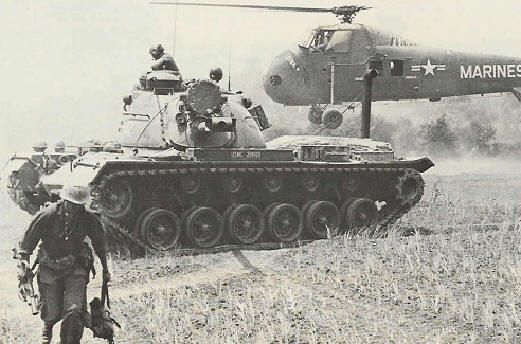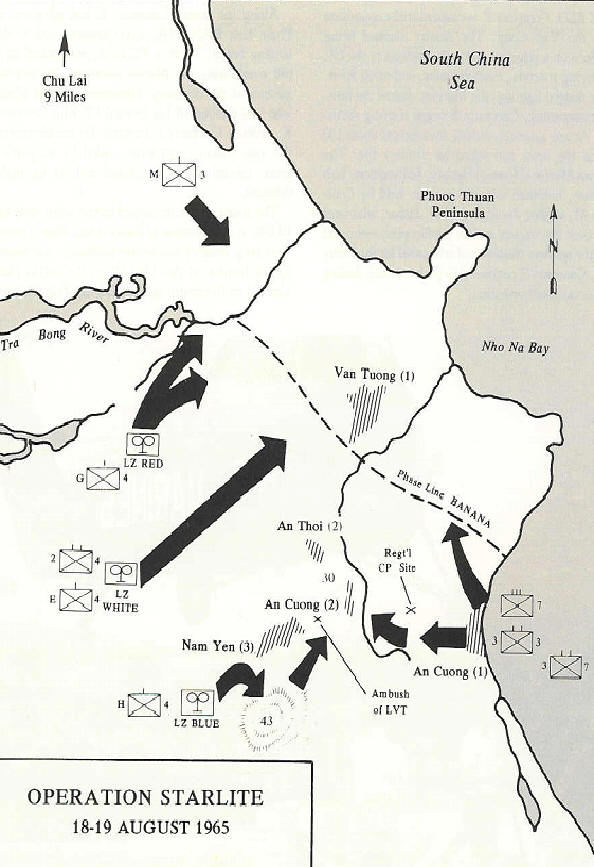Operation Starlite: The First Big Battle (17-24 August 1965)
Submitted by Lt. Col. Ray Stewart, USMC (Ret.)


MARINE CORPS TANKERS VIETNAM HISTORICAL Foundation's
Vietnam Personal Accounts
§
Operation Starlite: The First Big Battle (17-24 August 1965)
Submitted by Lt. Col. Ray Stewart, USMC (Ret.)

Note: This is a 3rd Tank Battalion, Alpha Company, Third Platoon Tank – A32. Sponson box number is 201901
When the 9th Marine Expeditionary Brigade (MEB) came across Red Beach in Danang, Republic of Vietnam under the command of Brigadier General Frederick J. Karch, USMC on 8 March, 1965 it had orders to “dig in and hold”. The Army of the Republic of Vietnam (ARVN) was in command and, according to BGen Karch’s statement to the press “Our job is to secure the area. We’ll be operating strictly in a defensive role”.
So, while the South Vietnamese troops were free to seek out and engage the enemy, Marines were pretty much confined to “behind the wire”. The Danang “enclave” was referred to by some Marines as “The Alamo”. From “The Alamo” Marines could fire only when fired upon. In some instances Marines observed “troops in the open” but by the time they could obtain permission to shoot, the opportunity was lost.
Further to the south in an area called Chu Lai*, 55 miles from Danang, things were a bit different. In June of 1965 the Marine Radio Battalion intercepted and reported an increase in message traffic between several known Viet Cong units concentrated on and around the Van Tuong Peninsula 15 miles south of the Chu Lai enclave. The Marine cantonment included a new U.S.-built airfield. These intercepts alerted the aerial intelligence collection assets which confirmed “unusual activity” including the building of bunkers and other positions.
During mid-August, 1965 an enemy deserter informed his interrogators that the 60th and the 80th Viet Cong Battalions, with reinforcement from the 52nd Weapons Battalion comprised a unit called the First Viet Cong Regiment. This 1,500-man regiment intended to attack the just-being-built Chu Lai enclave and airfield from its staging area on the Van Tuong Peninsula.
Army General Westmoreland, the Commander in charge of all military operations in Vietnam located in Saigon and is staff grew increasingly concerned that the Viet Cong were preparing to mount an attack on Chu Lai with “up to 3 regiments of Viet Cong”. The concern was shared by LtGen Lewis Walt, Commanding General of the III Marine Amphibious Force (MAF). Gen. Westmoreland “encouraged” Gen. Walt to take the offensive. Gen. Walt “reminded” Gen. Westmoreland of the 6 May letter limiting Marines to support of the ARVN. Gen. Westmoreland told Walt that these constraints were “no longer realistic” and ordered Gen. Walt to re-write the Rules of Engagement. Gen. Walt did so and on 6 August Gen. Westmoreland gave Gen. Walt “official permission to take offensive action against the enemy”. A week later the 7th Marines landed in Chu Lai. RLT 7, reinforced with by Capt Allen W. Lamb’s, “B” Company, 1st Tank Bn., was commanded by Col. Oscar F. Peatross. BLT 1/7, reinforced by the 1st Platoon, “B” Company, 1st Tanks, arrived on 14 August.
Third Tank Battalion, headquartered in Danang, had already deployed some of its tanks to the Chu Lai Tactical Area of Responsibility (TOAR) in support of the 3rd Marines (A Company, commanded by Capt. Fidelas W. Jarnot) and the 4th Marines (C Company, commanded by Capt. Joe P. Sanders).
With increased enemy activity reported around the Van Tuong village complex and the arrival of the 7th Marines – along with permission to engage the enemy - Gen Walt and his staff flew to Chu Lai. There was but one of 2 choices – sit and wait for the Viet Cong to attack or take the battle to the enemy. Predictably, the Marines chose the latter and Col. Peatross was given command of the attacking force. Col. Don Wyckoff, Third Marine Division Operations Officer, designated the operation “Satellite” but as a young PFC smoothed out the plan, the generators failed and the clerk – with only a candle for light, altering history – typed “Starlite” instead of “Satellite” throughout the document.
The operation was to be a 2 battalion assault – Lieutenant Colonel Fisher’s 2nd Battalion, 4th Marines and Lieutenant Colonel Joseph E. Muir’s 3rd Battalion, 3rd Marines. One battalion – LtCol Muir’s - was to land across the beach and one battalion – LtCol fisher’s - to land by helicopter further inland. A third battalion, the 3rd Battalion, 7th Marines – BLT 3/7, reinforced by 2Lt. Raymond A. Stewart’s 3rd Platoon (rein), “B” Company, 1st Tanks embarked on the Point Defiance LSD 31 – commanded by LtCol Charles H. Bodley, was designated as the floating reserve. Artillery support was to be provided by Marine Batteries in Chu Lai. Naval Guns were on call and MAGs -11 and -12 were to fly Close Air with Helicopter Squadrons 261 & 361 supporting the vertical envelopment.
If the creation of the attacking regimental-size force under Col. Peatross – drawing units from both the 1st and 3rd Marine Divisions (3rd Marines from Okinawa, 4th Marines from Hawaii, and 7th Marines from Camp Pendleton was complicated and difficult, Capt. Lamb’s supporting job was no less so. He was tasked to provide tank – both gun and flame – support into an area 12-15 miles south of Chu Lai that was only marginally “tank country”.
On 17 August selected 1st and 3rd Tank Battalion tanks loaded into amphibious shipping for the amphibious assault while others moved overland from Chu Lai to link up for the follow-on assault on the 1st VC Regiment bunkered on the Van Tuong Peninsula.
On 18 August Company B (-)(rein) moved out. It consisted of:
CoB(-), 1st TkBn, FMF
3d Plat, CoA, 3dTkBn, FMF
Sec. 2d Plat, CoC, 3dTkBn, FMF
CoB(-) consisted of (1) Gun Tank, three (3) Flame Tanks, and a VTR, M51.
Total Strength 3 Officers USMC
43 Enlisted USMC
1 Enlisted USN
The tank elements were organized into three separate increments.
The section of 2d Plat, CoC was attached to LtCol Fisher’s BLT 2/4. 3d Plat, CoA was attached to Lt. Col Muir’s BLT 3/3. Capt. Lamb’s Company B(-) was with Hq, RLT-7 in a General Support role.
BLT 3/3, after an amphibious landing with Gun Tanks, Flame Tanks, and Ontos, and 2/4, with their supporting tanks attached, joined up outside the Hamlet of An Cuong (2). The terrain was “primarily rolling, weeded or brush-covered interspersed with dry crop fields, wet rice paddies, and paddy dikes”. Hedgerows of small trees and brush from 6-10 feet divided up the terrain.
From the heavy brush, the well-concealed enemy knocked out A34 with an RPG. A section of Company C tanks assisted in evacuating the A34 crew then returned to the 2/4 defensive positions. Then, a light section (2 tanks) of 3d Plat, CoA found itself without supporting infantry and wisely returned to 2/4’s position. A33 escorted A35, which had experienced “track problems”, returning to the beach.
At approx. 1100, India Company, 3/3 in contact with the enemy requested Flames at their position. The route between the RLT Hq. and India Company was reported “clear”. The Flames fell in with a 5 LVTs resupply convoy. The convoy, after passing Hotel Company 2/4, which had supporting tanks, got lost. As the convoy, following a trail flanked by trees on one side and rice paddies and hedgerows on the other, was ambushed. “As the two lead vehicles, a tank and an amtrac, went around a bend in the road, and explosion occurred near the lead tank, followed by another in the middle of the column.” The enemy opened up with RPGs, mortars, and small arms. B55 was hit and put out of action. The wounded crew was evacuated. The LVTs, attempting to avoid contact drove into a rice paddy and immediately bogged down. B53, having expended its .30 cal. Ammunition, with its .50 cal. out of action, and the driver wounded by blown out fragments of the driver’s periscope (the enemy, taking advantage of the lack of infantry support for the tanks, ran right up to the tank and laid a satchel charge on the drivers hatch, blowing the periscope vision blocks down onto the driver), broke contact and returned to RLT CP.
Understanding the difficulties the convoy was experiencing, a reaction force from BLT 3/3 mounted out, with B51 as an escort, on LVTs. In route the Reaction Force was taken under fire. B51 stopped to engage the enemy running across its direct front with its .30 cal. and was hit by an RPG from that direction. As the LVTs closed up from the rear, they came under fire from the same directions and then from the flanks. The LVTs dispersed, leaving B51 to fire its canister. Not being able to determine the exact location of the flanking fire, B51 broke contact.
Another attempt was made to relieve the beleaguered column around 1600 with Company L as the Reaction Force and – once again – B51, along with A33 and the VTR, as escorts. Contact was made with the enemy. By the time the enemy could be cleared it was too dark to determine the location of the “lost” column and the Reaction Force circled its wagons into a defensive position until first light.
Early on the morning of 19 August 1965, helicopters arrived at the column’s position and began to evacuate the wounded and KIAs. Companies L and I of 3/7 along with B51, A33, and the VTR moved into the area as well and assisted in burying the enemy and evacuating the friendly casualties. Vehicle recovery also was undertaken. On 20 August vehicle recovery was completed. Unable to recover one tank - A34 – and one LVT, both were blown in place by the Engineers.
Company B (-)(rein), 1st Tanks suffered 1 KIA and 13 WIA during Operation Starlite. Its commander, Capt Al Lamb (B51) was awarded a Silver Star for his heroic action. He retired a Colonel.
“The exploits of the infantry battalions were only part of the story of the battle. Colonel Peatross had high praise for both the tank and engineer detachments to his command”. The 7th Marines Commanding Officer, Colonel Peatross, is quoted “the tanks were certainly the difference between extremely heavy casualties and the number we actually took. Everyplace the tanks went, they drew a crowd of VC.”
So, the mis-named battle “Operation Starlite” that “started it all” - with 45 Marines KIAs and 203 WIAs - cost the Viet Cong 614 killed. And, while the Viet Cong were to never again to field a military unit against the Marines, the Marines continued to win battle after battle for the next five years.
* “Chu Lai” was not an actual “place” – not found on any map, not even a Vietnamese name - but rather an unnamed “flat spot to build a runway on”. Unnamed, that is, until Marine LtGen. Victor Krulak, FMFPac Commander, while flying over the area on a recon to find a suitable place to build an airfield and supporting cantonment, named it. “Chu Lai” which are the Mandarin Chinese characters for “Victor Krulak”.
(Note: Material for this article is taken from the Official Marine Corps Command Chronologies, Capt. Al Lamb’s After Action Report, “U.S. Marines in Vietnam – 1965”, and articles by Tom Bartlett appearing in the August 1990 and 1985 “Leatherneck”. You are encouraged to write, call, or e-mail the Foundation with your comments.)